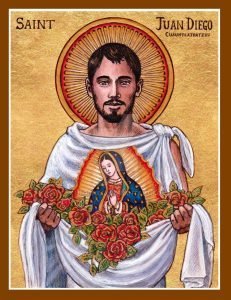FEAST OF SAINT JUAN DIEGO
FEAST DAY – 9th DECEMBER
Juan Diego, (1474–1548), a Chichimec peasant and Marian visionary, is said to have been granted apparitions of the Virgin Mary in December 1531, three at the hill of Tepeyac and a fourth before don Juan de Zumárraga, then bishop of Mexico. The Basilica of Our Lady of Guadalupe, located at the foot of Tepeyac, houses the cloak (tilmahtli) that is traditionally said to be Juan Diego’s, and upon which the image of the Virgin is said to have been miraculously impressed as proof of the authenticity of the apparitions.
Little is known of the early life of Juan Diego, whose original name was Cuauhtlatoatzin (“the Talking Eagle”). Although he described himself as poor, he may have meant poor in spirit; it has been suggested that he was an Aztec prince. He was married but had no children. When he was 50 years old, he and his wife were among the first indigenous people to accept baptism and convert to Christianity after its introduction to Mexico by Spanish conquistadors and missionaries.
According to tradition, Juan Diego experienced his first vision of the Virgin Mary on December 9, 1531. While on his way to mass, he was visited by Mary, who was surrounded in heavenly light, on Tepeyac Hill on the outskirts of what is now Mexico City. She spoke to him in his native language and asked him to tell the bishop to build a shrine to her on the hill. The bishop did not believe Juan Diego’s story and asked for proof that Mary had appeared to him. On December 12, while searching for a priest to administer last rites to his uncle, Juan Diego was visited by Mary again.
He told her of the bishop’s answer, and she instructed him to gather roses and take them to the bishop as a sign. She also informed Juan Diego that his uncle would recover from his illness. Juan Diego found many roses on the hill even though it was winter. When he opened his tilma (cloak) while appearing before the bishop, dozens of roses fell out, and an image of Mary, imprinted on the inside of his cloak, became visible. Having received his proof, the bishop ordered that a church be built on Tepeyac Hill in honour of the Virgin. Juan Diego returned home and found his uncle’s health restored.
For the rest of his life Juan Diego lived in a hut next to the church built in honour of Mary and took care of the pilgrims who came to the shrine. He was buried in the church, and his tilma can still be seen in the Basilica of Our Lady of Guadalupe. His existence, which had been questioned by Catholics and non-Catholics alike, was confirmed by the Vatican, and Juan Diego was beatified on May 6, 1990, and canonized on July 31, 2002, by Pope John Paul II. Numerous miracles have been attributed to him, and he remains one of the most popular and important saints in Mexico. His attributes are a tilma with the impressed image of the Virgin Mary, and roses and he is patron of all the indigenous peoples of the Americas.
PRAYER
St. Juan Diego, our first saint from the Americas, pray for us. We ask God the Father to pour forth the protecting love of his Spirit upon all migrants, taking special heed of those in need of support, who are isolated or separated from their native lands, whether by choice or necessity.
St. Juan Diego, intercede for those torn away from their families in pursuit of work that they may be reunited, husbands with wives and parents with children. As the Virgin of Guadalupe promised you her compassionate prayers for the poor of Mexico, so now raise your merciful pleading for migrant women and children who are particularly vulnerable to the dangers of human trafficking.
Seek for them protection from all evil. May we, O Blessed Juan Diego, receive through your prayers, the grace to welcome with love to our country all migrants who seek a home in our parishes and communities. And we ask that you join your prayers to those of Our Lady, who appeared to you as your Mother and as Mother of all in our land.
May she wrap her mantle of protection around all migrant people. We beg for her love, compassion, help, and protection on all immigrants who today experience great sufferings, sorrows, necessities, and misfortunes. In the shared power of Christ and the union of the Holy Spirit, we say: Amen.
(Copyright © 2012, United States Conference of Catholic Bishops, Washington)
